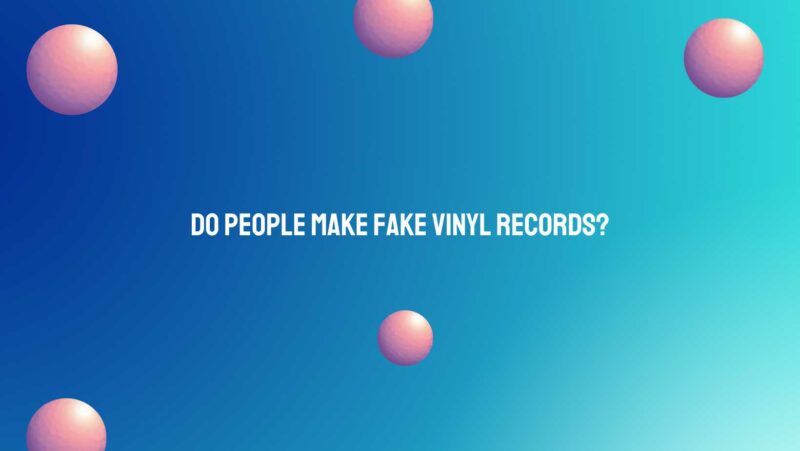Vinyl records have enjoyed a resurgence in popularity in recent years, with enthusiasts and collectors worldwide celebrating their unique sound and tangible charm. However, with the resurgence of vinyl’s popularity comes an unfortunate side effect – the rise of counterfeit vinyl records. In this comprehensive article, we will explore the intricate world of fake vinyl records, examining the motives behind their creation, the methods used, and the consequences for collectors, artists, and the industry as a whole.
Why Create Fake Vinyl Records?
Counterfeiting vinyl records is driven by a combination of financial gain, nostalgia, and an appreciation for the art form itself. Here are some key motives behind the creation of fake vinyl records:
- Financial Gain: The vinyl market has experienced a significant resurgence in the 21st century, with some records fetching exorbitant prices. Counterfeiters aim to capitalize on this trend by producing fake versions of sought-after albums and selling them at a premium. Collectors, in their quest for rare records, can sometimes be willing to pay substantial amounts for a counterfeit without realizing its inauthenticity.
- Nostalgia: Some counterfeiters are avid vinyl enthusiasts themselves and attempt to recreate vintage records that are no longer in production. These individuals may do it purely for personal satisfaction, but their creations can still end up in circulation, deceiving buyers.
- Artistic Challenge: Counterfeiters may see the creation of fake vinyl records as an art form in itself, attempting to replicate the look and feel of vintage records with meticulous attention to detail. While this is less common, it underscores the passion that drives some counterfeiters.
Methods Used in Creating Fake Vinyl Records
Counterfeiters employ various methods to produce fake vinyl records, and these methods can range from rudimentary to highly sophisticated:
- Vinyl Replication: Some counterfeiters use modern vinyl pressing equipment to create counterfeit records. They may have access to a legitimate copy of the album and use it as a template for their forgery. This method can result in records that closely mimic the appearance and sound of authentic ones.
- Labels and Sleeves: Counterfeiters often pay great attention to replicating the album’s labels, covers, and sleeves. High-quality scanning, printing, and paper selection can make it challenging to distinguish a fake from an original at first glance.
- Bootlegging: Bootlegging involves copying live performances or unreleased tracks onto vinyl records. While these records may not be counterfeit in the traditional sense, they are unauthorized and can deceive collectors who believe they are purchasing rare, legitimate releases.
Consequences of Fake Vinyl Records
The presence of counterfeit vinyl records has far-reaching consequences for collectors, artists, and the music industry:
- Financial Loss for Collectors: Buyers who unknowingly purchase counterfeit records can suffer significant financial losses, as they often pay a premium for what they believe to be rare or valuable items.
- Damage to Artist Reputations: Counterfeiting not only affects collectors but also harms the reputation of artists and record labels. Fake vinyl records can lead to a loss of trust between artists and their fanbase.
- Legal Ramifications: Counterfeiting is illegal, and those caught producing or selling fake vinyl records can face legal consequences, including fines and imprisonment.
- Erosion of Collectors’ Confidence: The presence of counterfeit records erodes confidence in the authenticity of vinyl collectibles, making it more challenging for collectors to discern genuine items from fakes.
Preventing and Detecting Fake Vinyl Records
To mitigate the impact of counterfeit vinyl records, collectors and enthusiasts can take the following measures:
- Research: Educate yourself about the specific album or artist you are interested in. Familiarize yourself with the discography, label variations, and any known counterfeits.
- Inspection: Examine the record closely for inconsistencies in label design, printing quality, and overall craftsmanship. Authentic vintage records often have specific manufacturing characteristics.
- Authentication Services: Consider using professional authentication services to verify the authenticity of valuable records. These services can provide certificates of authenticity and expert opinions.
- Trusted Sources: Purchase vinyl records from reputable sellers, record stores, or online marketplaces with a history of selling authentic items. Be cautious of deals that seem too good to be true.
Conclusion
The world of vinyl records, with its rich history and resurgence in popularity, has unfortunately attracted counterfeiters seeking to exploit the enthusiasm of collectors. Detecting and preventing fake vinyl records requires vigilance, research, and a commitment to supporting artists and the music industry. By staying informed and purchasing from reputable sources, vinyl enthusiasts can continue to enjoy the unique experience of authentic records while safeguarding their collections from the counterfeit threat.

